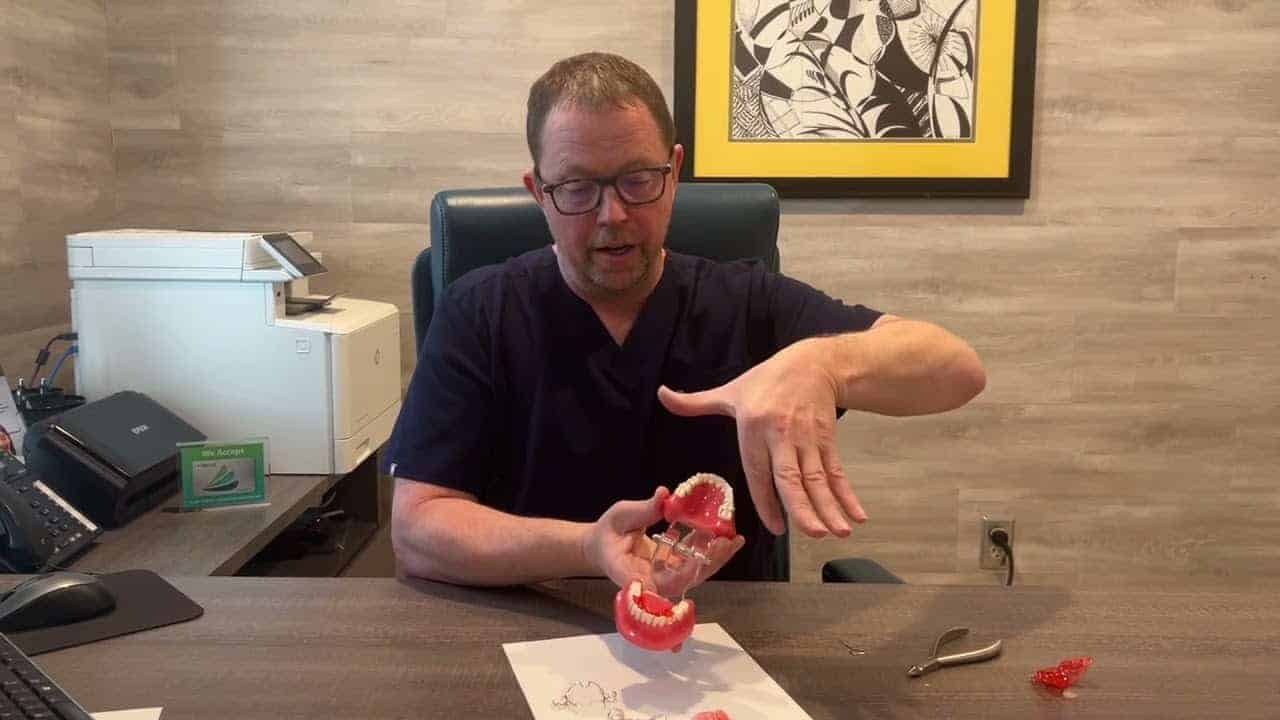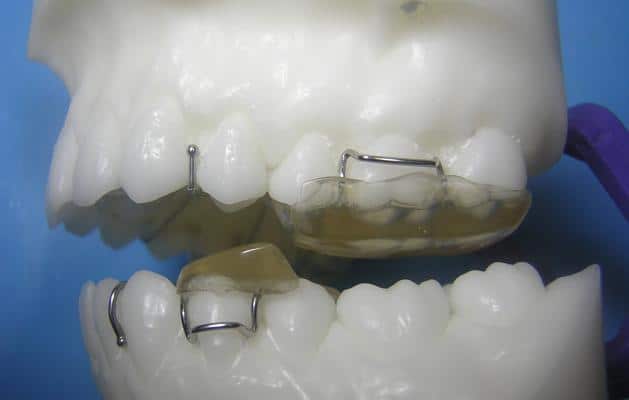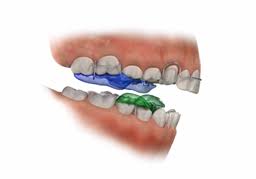Key Points about Twin Block Devices
- The Twin Block appliance is a customized, removable orthodontic device designed to correct jaw misalignments and improve facial structure by positioning the lower jaw forward, typically over a 7 to 9 month period, and is particularly suitable for growing children and adolescents.
- While the Twin Block appliance offers advantages like enhanced facial aesthetics, improved bite, and patient comfort due to its custom fit and removability, it may initially cause discomfort and has a risk of developing an anterior open bite that could require additional orthodontic treatment.
- Post-Twin Block treatment may involve fixed orthodontic devices or surgery for severe cases to refine dental alignment or adjust jaw position, respectively, with the Twin Block appliance often serving as a preparatory stage before such interventions.
Understanding the Twin Block Appliance
In the realm of orthodontics, the Twin Block appliance emerges as an innovative standout. Comprised of two interlocking bite blocks that position the lower jaw forward, this removable functional device harnesses the natural growth process to correct misalignments. With a typical treatment duration ranging from 7 to 9 months, the Twin Block technique is not just about straightening teeth; it’s about harmonizing the entire facial structure.
This orthodontic innovation is not a one-size-fits-all solution. The Twin Block treatment is highly adaptable, making it an ideal appliance for a variety of malocclusions and ages, especially children and adolescents in their growth spurt phase. It’s a personalized journey toward a more balanced bite and a more confident smile.
The Design Principles of Twin Blocks
Customization is central to the Twin Block design. Each set of bite blocks is uniquely crafted to fit the upper and lower plates of the individual’s mouth, enabling a precise correction of jaw misalignment. The innovative aspect of the Twin Block treatment is its ability to integrate expansion screws, which can widen the upper arch—showcasing the appliance’s capability to perform dental expansion when necessary.
Children, particularly those with a retruded lower jaw and protrusive upper front teeth, find the Twin Block to be the ideal appliance. It offers a non-invasive solution to ‘buck teeth,’ guiding the lower jaw into a more forward position incrementally and promoting a balanced facial profile.
How Twin Blocks Shifts the Lower Jaw Forward
The Twin Block technique uniquely enables mandibular advancement—a gentle, yet potent, maneuver that guides the lower jaw forward. This not only corrects a retrusive mandible but can also orchestrate the expansion of the maxilla, optimizing the duration and outcomes of the treatment. Dental changes such as the retraction of maxillary incisors and the protrusion of mandibular incisors are instrumental in enhancing the bite and overall facial esthetics, resulting in a harmonious, confident smile.
Remarkably, patients typically find the standard Twin Block appliance comfortable. It allows them to speak and eat with minimal disruption—testaments to the thoughtful twin block design that prioritizes patient comfort alongside dental correction.
Twin Block vs. Other Functional Appliances
For younger patients mulling over orthodontic treatment options, the Twin Block appliance frequently emerges as a preferred choice. Its ability to utilize the natural growth spurt for correcting skeletal discrepancies makes it a more desirable option compared to fixed appliances like the Herbst appliance, which may be suited for non-growing patients needing significant jaw realignment. The Twin Block’s adjustability allows for a tailored approach to treatment, providing customization during various phases that fixed functional appliances like Herbst appliances cannot offer.
Moreover, the removable nature of the Twin Block, a type of removable appliance, contributes to better patient compliance, given the ease of removing the appliance as needed. Its acrylic material and lack of palatal coverage can make it more tolerable for patients compared to other functional appliances, contributing to its acceptance and comfort.
The Benefits and Limitations of Twin Block Treatment
The Twin Block technique excels in effectively rectifying overjet and mandibular retrusion, which leads to enhanced facial aesthetics, notably a more pronounced chin and a balanced profile. Most patients begin to see improvement within the first 6-12 months of treatment, which can be a remarkably swift transformation for those accustomed to the extended timelines often associated with orthodontic treatment.
Despite these compelling benefits, there are inherent challenges in any treatment. The bulkiness of the Twin Block appliance can cause initial discomfort or difficulties in speaking and swallowing. Additionally, there’s a risk of developing an anterior open bite if posterior teeth erupt during the treatment, which could necessitate further orthodontic measures.
Advantages of Twin Block Therapy
Among the many positive aspects of Twin Block therapy, its convenience is particularly appreciated. Designed for full-time wear, the appliance can be removed during eating, tooth brushing, and activities such as contact sports and swimming. This flexibility demonstrates the ease of use and adaptability of the Twin Block, accommodating the patient’s lifestyle while ensuring consistent treatment.
Potential Challenges During Treatment
Though the advantages are numerous, patients starting Twin Block treatment may initially encounter speech difficulties. This challenge, however, is not insurmountable. Practice and patience typically lead to improvement, as patients quickly adapt to their new oral landscape.
Twin Block Technique: A Step-by-Step Process
The path to achieving a balanced jaw alignment with the Twin Block technique initiates with an exhaustive initial consultation. Here, the patient’s eligibility for Twin Block therapy is assessed, and the mechanism, treatment timeline, and expected compliance are discussed in detail. Each appliance is custom-made, taking into account dental and skeletal morphology to ensure a snug fit and optimal activation, marking the beginning of a tailored orthodontic experience.
Throughout the treatment, the Twin Block appliance requires periodic adjustments—usually every 4-6 weeks—to fine-tune the positioning of the jaw as it moves into alignment. The commitment to regular follow-ups is a testament to the personalized care and attention to detail inherent in the Twin Block technique, with the treatment duration varying from patient to patient.
The success of Twin Block therapy is evaluated through:
- Consistent monitoring of jaw advancement
- Monitoring of occlusal changes
- Culminating in a final assessment to confirm the desired dental and facial outcomes.
Initial Assessment and Fitting
Accurately fitting a Twin Block appliance is an art in precision. During the initial assessment, the orthodontist takes great care to ensure that the customized appliance will fit perfectly within the patient’s mouth. Any necessary adjustments are made during the appliance delivery, ensuring not only comfort but also proper function from day one.
Living with Twin Blocks: Adjustments and Maintenance
Adjusting to life with Twin Blocks involves adopting a routine to care for the appliance. When not in use, it should be stored in a retainer case to prevent damage. Post-meal brushing is crucial for hygiene, and a specialized cleaning solution is recommended for a weekly deep clean.
Regular dental visits, typically scheduled every 6 to 10 weeks, are essential for monitoring both progress and the upkeep of the appliance.
Tracking Progress and Completing Treatment
The transformative journey of patients using Twin Block appliances, captured through regular monitoring, spans 12 to 24 months of full-time wear. The successful completion of treatment is a collaborative achievement, relying on sufficient mandibular advancement and the patient’s growth.
Duration of wear and cooperation are pivotal factors that influence the timeline, culminating in a smile that reflects both aesthetic appeal and functional integrity.
Case Studies: Twin Block Treatment in Action
Real-life experiences frequently resonate more than clinical jargon, which is precisely what the Twin Block treatment case studies illustrate—concrete results leading to transformative smiles. These narratives not only demonstrate the cosmetic enhancements of jaw alignment but also highlight the functional improvements in patients’ bites. For instance, Patient A’s severe overjet of 10 mm was dramatically reduced, resulting in an improved facial profile that radiated confidence.
Another success story is that of:
- Patient B, who, with a mild Class II malocclusion, achieved a complete correction after 12 months of dedicated Twin Block therapy.
- Patient C, who presented with an increased overjet and crowding, and through the combined treatment of Twin Block and subsequent braces, achieved harmonious jaw alignment and tooth positioning.
- Patient D, who was able to forego jaw surgery, initially considered a necessity, thanks to the corrective power of the Twin Block appliance.
From Overbite to Ideal Alignment
The transition from an overbite to optimal alignment is an incredible transformation, frequently facilitated by the Twin Block appliance. This is evidenced by the significant reduction in overjet and overbite that patients experience, reshaping not just their dental structure but also their self-perception.
Following the retention phase, the introduction of fixed orthodontic appliances can refine dental alignment and facial balance, further enhancing the transformative effect of the Twin Block therapy.
The impact of this transformation extends beyond aesthetics. For a male adolescent patient, the improved alignment from Twin Block therapy brought a newfound confidence, a testament to the power of a smile that aligns with one’s self-esteem.
Enhancing Retention Post-Twin Block Treatment
Once the desired jaw alignment is achieved with Twin Block treatment, the emphasis pivots to preserving those results. This retention phase is critical, and various options such as fixed retainers or removable appliances are considered to ensure the corrected position remains stable.
The use of retainers after Twin Block treatment is essential to prevent relapse and is a commitment to the permanence of the patient’s new smile. To support this, Twin Blocks are often worn for an additional 12 hours a day during the retention phase, safeguarding the alignment that has been meticulously achieved.
Beyond Twin Blocks: Exploring Additional Orthodontic Solutions
Despite the transformative power of Twin Block appliances, the orthodontic journey may necessitate further steps. After Twin Block therapy, it may be necessary to use fixed orthodontic devices, such as braces, to fine-tune dental alignment and correct the bite with Invisalign. Braces offer precise control over individual tooth movement, which is essential for the final detailing of occlusion, especially after major skeletal corrections have been achieved. For those seeking a less conspicuous solution post-Twin Block, Invisalign or other clear aligner systems present an aesthetically pleasing alternative, combining the benefits of removability and subtlety.
Minor tooth movements that Twin Block appliances may not fully correct can be addressed with additional orthodontic solutions such as sectional braces or customized clear aligners. These interventions ensure that the significant modifications to dental arches and bite achieved by Twin Block therapy are refined to perfection, achieving the ideal intercuspation and ensuring a flawless smile.
Combining Twin Blocks with Fixed Orthodontic Treatment
Employing Twin Blocks strategically before fixed orthodontic treatment can optimize overall results, culminating in a comprehensive correction approach. This sequential treatment approach, where a patient first undergoes correction of Class II malocclusion with a Twin Block appliance, followed by transition to fixed appliance therapy, has proven effective for many patients.
A case in point is a 13-year-old male who, through this two-phase treatment protocol, significantly improved his dental and facial profile, achieving a Class I molar relationship after 24 months of diligent care.
The Role of Surgery in Severe Cases
When skeletal discrepancies exceed the corrective capabilities of orthodontic appliances like the Twin Block, surgical intervention may be considered. Surgical interventions such as orthognathic surgery to reposition jawbones or genioplasty to adjust the chin position can provide the necessary alterations for patients with severe misalignments. The Twin Block appliance can serve as an effective preparatory treatment, moving the lower jaw forward and setting the stage for a successful surgical outcome.
Coordinating Twin Block therapy with the timing of surgery can significantly enhance post-surgical stability, ensuring the lasting impact of the treatment.
Summary
We’ve traversed the transformative landscape of the Twin Block technique, exploring its design, benefits, and the profound impact it has on patients’ lives. From the initial consultation to the diligent aftercare, each step of the journey with the Twin Block appliance is tailored to achieve not just an aligned jaw but also a harmonious facial profile. These real-world successes are a testament to the appliance’s effectiveness, and with additional orthodontic solutions, the path to an ideal smile is well within reach. Let these stories inspire confidence in the pursuit of a smile that truly reflects your inner vitality.
 703-712-1053
703-712-1053 


